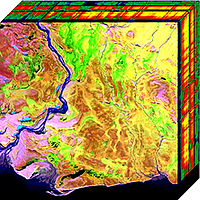
Photo from wikipedia
Abstract Potato with minor bruise is difficult to be detected in the process of damage identification and is perishable in storage, thus leading to a serious problem of food safety… Click to show full abstract
Abstract Potato with minor bruise is difficult to be detected in the process of damage identification and is perishable in storage, thus leading to a serious problem of food safety and economic issue. In view of the complexity of bruise detection for potatoes, a nondestructive detection method, based on hyperspectral imaging technique, has been proposed in this study. In this research, its potential for non-destructive detection of bruised potatoes has been investigated. All samples, including healthy and bruised potatoes belonging to 3 different levels, were taken as experiment objects, where bruises were induced by a device for quantitative damage and these samples were divided in 3 levels (level I, II, and III bruises) according bruised degree. First of all, the background in every hyperspectral image was removed by masking aiming at acquiring the average spectra of each potato. Then, Savitzky-Golay smoothing, first derivative, second derivative, standard normal variate, multiplicative scatter correction and their combinatorial methods were applied to pre-process spectral data, respectively, and the grid search algorithm was applied to optimize modeling parameters. Confirm that the second derivative combining with standard normal variate reinforced the model performance at utmost, and the identification accuracy of bruised samples reached 87.88%. In addition, given the interference of redundant information, the optimized simulated annealing algorithm based on correlation coefficient algorithm was applied to reduce the dimension of the spectral data, which promoted the identification accuracy of bruised samples to 100%. Furthermore, the bruise levels of samples were classified via reducing dimensionality and pre-processing technology, and the higher classification accuracy of 100% was achieved. The results indicated that potato with minor bruise could be identified accurately and effectively and the bruise levels could be classified by the hyperspectral imaging technique, which provided an idea for on-line and non-destructive testing of potato.
Journal Title: Chemometrics and Intelligent Laboratory Systems
Year Published: 2018
Link to full text (if available)
Share on Social Media: Sign Up to like & get
recommendations!